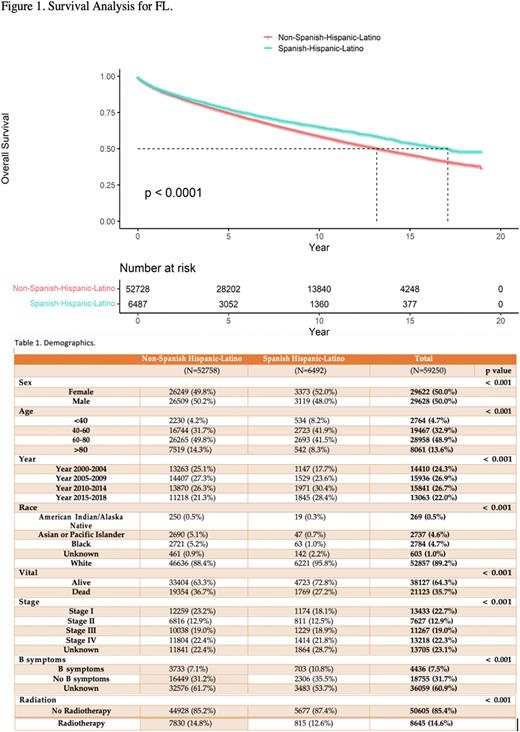Abstract
Background
Follicular lymphoma (FL) is the most common indolent non-Hodgkin lymphoma (NHL) in the Western hemisphere (Blood PMID: 26989204). In prior studies, better progression-free survival has been noted in Hispanics (HI), however, further characterization of this ethnic difference needs to be addressed. This result is consistent with previous research explaining the development of NHL as an heterogeneous process where unique outcomes for races have been noted. There is a need for further understanding of HI diagnosed with FL.
METHODS: Data were analyzed on follicular FL patients in the United States (US) reported to the Surveillance, Epidemiology, and End Results (SEER) 18 database between 2000 and 2018. SEER 18 contains the most comprehensive population-based cancer information in the US, covering approximately 27% of the total US population, and up to 36% of HI alone. Racial groups analyzed included NH whites, HI whites, blacks, and Asians/PIs (Pacific Islanders). Patient characteristics, age-adjusted incidence rate, and survival rate were compared across ethnic groups, HI vs NH. Stratification by age, gender, and stage at diagnosis was considered. Kaplan-Meier and Cox regression analyses were used to compare overall survival (OS) between HI and NH. Multivariate analysis and propensity score matching were performed with adjustment for age, stage and B-symptoms.
RESULTS Of 59250 FL patients, 11% were HI, and 89% NH. 48% of HI were male, compared to 50% of NH. The majority of HI (42%) were diagnosed in the age bracket of (40-60) vs majority of NH (50%) who were diagnosed in the age bracket of (60-80) (p<0.001). HI were diagnosed at a median younger age, 59 y.o vs 65 y.o, compared to NH (p<0.001). Regarding race, most of HI and NH were whites (96% vs 88%), followed by blacks (1% vs 5%). When examining stage, most of HI (22%) as well as NH (22%) were stage IV (p<0.001). In terms of radiation, 13% of HI received it, compared to 14% of NH (p<0.001). On survival analysis, the survival probability at 2, 5 and 10 years of HI vs NH were (87%vs 86%),(77% vs 74%), and (64% vs 86%), respectively. The median survival time was 17.1 years for HI, vs 13.2 years for NH; and there was OS difference favoring HI/NH with (p<0.001). On multivariate analysis, when adjusted for age, those patients who were older than 80 y.o and between 60 to 80 y.o, had worse OS compared to those younger than 60 y.o, with hazard ratio (HR) 9.4 (95% CI: 8.7 - 10 ) and HR 3 (95% CI: 2.8-3.2) respectively. Regarding stage, those who were at stage III and IV, had worse OS than those at early stage (I/II) with HR 1.3 (95% CI: 1.26 - 1.45) and HR 1.7 (95% CI: 1.6 - 1.8), respectively.
CONCLUSION In this data analysis from the SEER 18 database, HI with FL lymphoma, had a statistically significant prolonged OS compared to NH. There were also, statistically significant differences in median survival at 2, 5, and 10 years among the HI cohorts. Unique characteristics from HI may explain why there is an increase in OS after a FL diagnosis in this data set. Biological differences in the background of HI with FL are needed to better understand improved outcomes on this cohort.
Disclosures
Diaz Duque:Incyte: Consultancy; Morphosys: Consultancy; Astra Zeneca: Consultancy; Epizyme: Consultancy; ADCT: Consultancy.
Author notes
Asterisk with author names denotes non-ASH members.


This feature is available to Subscribers Only
Sign In or Create an Account Close Modal